Averting Disaster - A Guide To Computer Backups (2014)
by Brett Howse on May 21, 2014 9:00 AM EST- Posted in
- IT Computing
- Mac
- Apple
- Windows
- Cloud Computing
- macOS
Built-in Backup Tools Windows 8.1
While Windows 7 and Vista had the Backup and Restore applet, Windows 8 introduced File History as the default backup option. File History is a replacement for Previous Versions from Windows Vista and Windows 7. Unlike Windows 7, File History does allow backup to network shares for all versions of Windows 8 which is a good thing and makes the software far more useful. The downside is that scheduled System Backups have been removed from Windows 8 and 8.1. You can still manually create a system backup, and you can perform a system backup to a network share, but you can’t schedule this to be run. Also, File History only performs a backup of files in your libraries (Documents, Music, Pictures, Videos, and Desktop folders), as well as any files saved locally from OneDrive. Still, the most important information on your computer is your files, so let’s look at how to enable this feature to protect them:
- Windows 8.1 adds the ability to enable File History from PC Settings, however the options are just to enable File History and to select a backup target, so these instructions will focus on the Control Panel applet which offers more advanced options. To launch File History, right click the Start button and choose Control Panel. Next expand System and Security and select Save backup copies of your files with File History.
- If File History has never been configured before, the system will scan for available disks that it can back up to. You can choose the disk, or use the link Select a network location to configure the disk.
- Once configured, simply click Turn On, and File History is enabled.
- If you’d like to modify your File History settings, that can be done in the File History applet. To exclude folders, choose Exclude Folders where you can select folders you wish to exclude from the backup. Unfortunately, you can’t add user defined folders here which you do want backed up. To add folders to be backed up, you either have to add that folder to an existing library, or create a new library.
- Advanced settings are also available in the File History applet, and these allow you to specify how often to run the File History backup (from ten minutes to daily) as well as specify how much of the PC’s disk to use as an offline cache (2% to 20%) in the event you are travelling and not able to access your backups, as well as to specify how many versions of files to keep.
Unlike Windows 7, File History’s interface is all in the control panel. It’s not as elegant as Previous Versions was, where you could right click any file or folder and see a list of all versions, but the interface is fairly straightforward and does show you a list of all of the backups:
- Launch File History by right clicking the Start button and opening the Control Panel. Next expand System and Security and select Restore your files with File History.
- The interface that opens up will be a listing of the locations you are backing up. The most recent backup will be displayed by default. To restore a file, navigate to the folder it was in, select the file by clicking it, and then press the green Restore button to restore it to the original location.
- If you’d like to restore it to a different location, right click the file and choose Restore To and then browse to your path.
- To navigate through your backups, you can use the skip buttons at the bottom of the page. The easiest way to sort though is to navigate to the folder where your file is (or was), and it will display only the backups that have changes in them. If a folder hasn’t been modified since you enabled File History, there will only be one backup for it. This is an easier method than trying to figure out which day you deleted a file.
Overall, File History is a decent built-in utility, but as is often the case, attempts to make the process easier to use often result in a system that is less powerful, and that’s certainly the case with this. Windows 7 lacked network backup for some versions, but overall the Windows 7 backup utility offered more features, especially with the automatic system backup. Previous Versions is also an easier way to find changes made to a file. File History also lacks a method of backing up files outside of your libraries and OneDrive folders which is not ideal by any means. Windows 8.1 forces you to make a system backup manually, and that can be done as so:
- Right click the Start button and open Control Panel. Expand System and Security, and then select Save backup copies of your files with File History which won’t actually be used, but is the shortcut to the System image backup.
- On the File History applet, click on System Image Backup in the bottom left corner.
- Choose a location for your backup. If it’s on a network share, you can optionally enter login credentials if required. Click Next.
- Now you will be prompted to confirm, and if you are happy click Finish. The confirmation dialog will estimate how much disk space will be required, and warn you that only a single backup file will be kept. In other words, there is no versioning.
If you are using File History as your backup method of choice, you should definitely create at least one system backup to allow you to restore to a new hard drive or machine if necessary. If you ever need to restore this, you can create a recovery drive by choosing the Recovery option in the File History applet. If you don’t have another computer to create this on if needed, it’s a good idea to create one ahead of time.
It is possible to create full scheduled backups, but only from the command line using wbadmin but this is not something I would recommend for the average user.



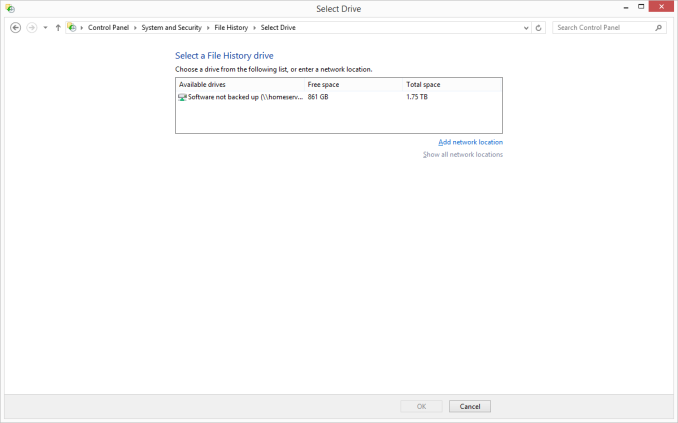
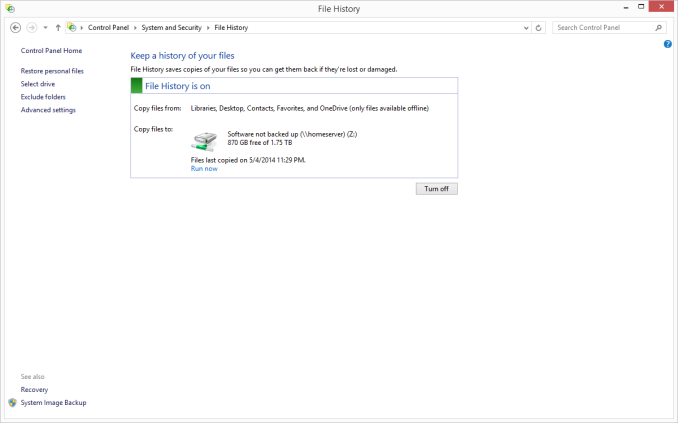
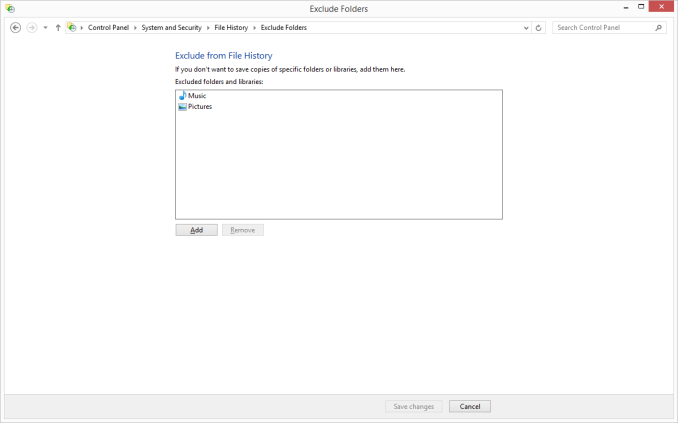
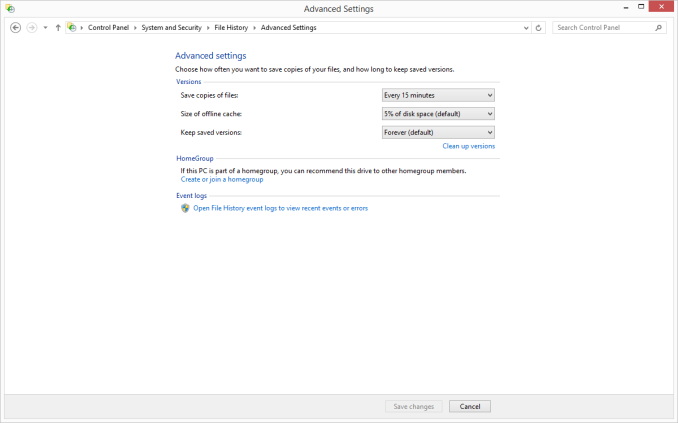





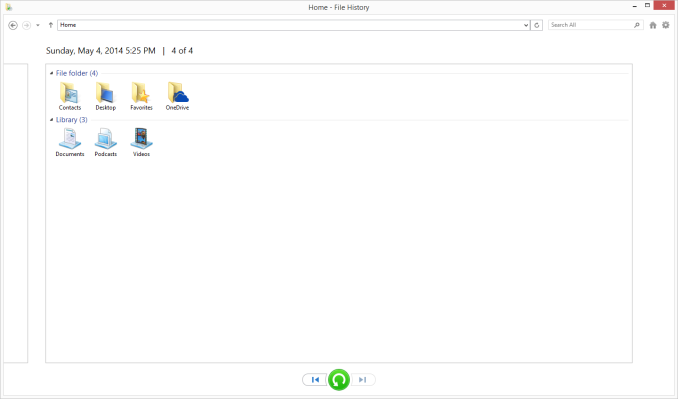










133 Comments
View All Comments
jimhsu - Thursday, May 22, 2014 - link
Availability, capacity, cost: pick two. Sounds like (for a business) that you need an enterprise-grade solution, and if you need next-day availability, crashplan won't be able to deliver that. Crashplan does offer initial drive seeding and backup-to-door: however those also take a week. If a single day of downtime is unacceptable, you probably need something in-house combined with professional services that offer overnight rush delivery -- and that's $$$.dstarr3 - Wednesday, May 21, 2014 - link
I took a much simpler approach. I have a hard drive which is just a clone of my entire computer, and I keep it in my desk at work. Once a week, I bring it home, run error checks, and do another clone onto the disk, take it back to work the next morning. I also have a local backup disk for files, a portable hard drive. The benefit is that one of my backups is off-site, and both of the backups are never plugged in during non-use, so there's no threat of power surges killing the drives. I'm only susceptible to fire or theft at this point, and that would have to happen to both my home and my work simultaneously to be a problem.rooman - Wednesday, May 21, 2014 - link
A drive at work is a good idea; an alternative (work isn't always an option) is to store the cloned drive in a safety deposit box which provides an extremely secure location. One probably wouldn't clone once a week, but once a quarter would protect against the worst case of total data loss.dstarr3 - Wednesday, May 21, 2014 - link
Yeah, I considered a safety deposit box, as well, but in some areas (like mine), it's bloody impossible to get one. hahaBeethovensCat - Saturday, May 24, 2014 - link
I did the same - am using SyncToy between my internal data drives and FreeFileSync between my computer and two external HDDs. The external HDD is entirely encrypted with TrueCrypt. I have a couple of external HDDs that are copies of my data drives (leave Windows on C: alone). Then I just take a drive to work once a week or two. Daily syncs (why bother with a backup program, when one can use a sync program?) to an encrypted USB stick. Works well and with 2Tb of HDD costing around 100$ there is no excuse for not having a couple of those.Kevin G - Wednesday, May 21, 2014 - link
Overall an excellent article!
Backups using Shadow Volumes should note some of its limitations: you'll need to have enough free disc space to store another copy of your largest file. For example, say you downloaded a 10 GB installed for a new game you'd need to have another 10 GB of free disk space for Window's Shadow volume to back it up. With the move to SSD's, this could be an issue in some cases.
I do agree that RAID IS NOT A BACKUP but when backing up to a NAS, the NAS should be using RAID 1/5/6 etc. A paragraph on the introductory page does go into these points but I've always felt the need to discuss backup reliability in this context. It helps clear up potential questions like 'if RAID isn't a backup, why are you backing up to RAID storage?' The answer is in the same paragraph as RAID projects against disk failure. Just in my experience, I typically need to hammer in the idea of what 'what good is backing up to a hard drive if a hard drive dies?' as the case for RAID 1/5/6 on a NAS. This idea can be obtained from the context of the article but I've found this needs more emphasis in my experience.
The issue of RAID disk failure leads into one topics that I've found missing: media reliability. The article mentions hard drives, USB sticks, optical and the cloud as targets for backup storage. (For consumer usage, I would say it is safe to omit tape but it still exists.) How long the media is stored and its ability to be retained over time does matter. This is more of a long term problem with USB and optical media as after several years, corruption can creep in. Hard drives of course can fail but typically they're in an active environment so that you'd know exactly when it failed. With RAID, it is possible to recover from failed media but once an optical disk rots or a USB flash stick is dead, the data on it is gone. This article does cover the media reliability of the cloud which is unique: you continually have to pay. Stop paying and you lose your backup data. There is one open question though with cloud backups as none have been around for a long time. Issues like outages are also possible with the cloud but so far many of the backup providers have been good in this regard.
ltcommanderdata - Wednesday, May 21, 2014 - link
For the built-in backup options for Windows 7/8 and OS X is there a way to limit the size of the backup without having to partition such that multiple computers can backup to one drive without directly competing with each other for space?For Time Machine you mention that it'll automatically delay the scheduled backup if the backup location is unavailable. Does Windows 7/8 do the same? I'm thinking of laptops that are always out and about so hopefully they won't throw up distracting error prompts when the network store location is not available.
Brett Howse - Wednesday, May 21, 2014 - link
I don't have any Windows 7 machines to test, so I can't answer that. Windows 8 has an offline cache though to which allows backups/restores when the device is disconnected:Advanced Settings in File History
File History allows you to fine tune how it works including:
Which target storage device is used
How frequently files are checked and backed up
How much space is used locally to cache backup versions of your files when the target backup device is disconnected
How long backup files are retained
Which folders in your libraries are excluded from backup
sepffuzzball - Wednesday, May 21, 2014 - link
Have to say...I've been running Windows Server Essentials 2012 since I was sad about WHS going by the wayside, and I love it.I'm running it in a VM on my ESXi server, it backs up all my clients with no issues. Then the WSE backs that up to a different storage pool (Solaris/ZFS), and then that gets kicked off-site.
Now I just need to find out a cheap solution to backup off-site the ~40TB worth of stuff on the file server (and then the upload speeds to actually back it up!).
coburn_c - Wednesday, May 21, 2014 - link
I just lost 6TB to a failed RAID 5 array. Thank you Seagate/China. The RMA drives are malaysian, so maybe that gives hope. Anyway, you can talk backups all you want but backing up 6TB is neither time nor cost economical.